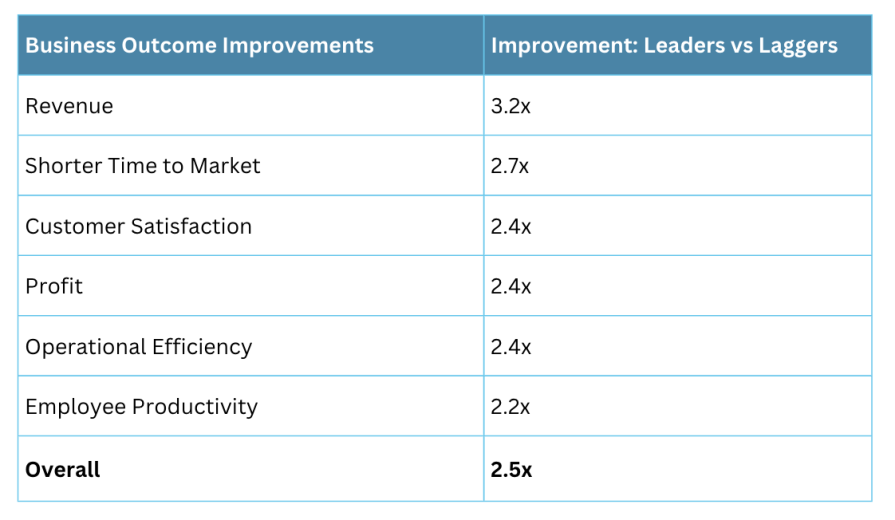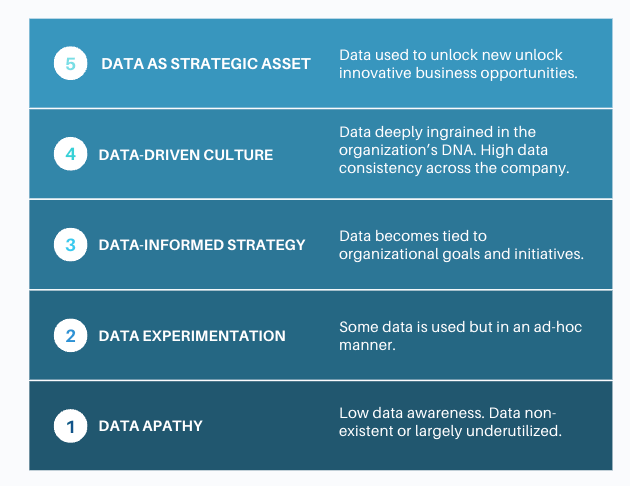
Can you imagine a company without insights into its financial data? For many organizations, this is where their journey into data maturity ends. Data is often superficial or nonexistent in areas beyond financial metrics, too, when there is no data maturity.
How data mature is your organization? Think of answers to these questions:
If you answered no to some of these questions, it’s time to advance towards a more data-mature organization and leverage the benefits of data.
Data-mature organizations effectively leverage data to make critical business decisions. They rely on objective insights rather than gut feelings or the opinion of the highest-paid person in the room.
Data is not confined to the finance and executive teams in data-mature organizations. While financial data is crucial, it alone is insufficient for other teams to take meaningful action. For instance, if financial data indicates a need to boost revenue, a product manager or a product development team must track more specific metrics to make informed decisions on achieving this goal.
Moreover, data and insights are embedded throughout every part of the organization, guiding decisions both big and small in a data-mature organization. Additionally, data aligns closely with the goals teams set for the upcoming quarter, ensuring data-driven roadmapping can be done, and goal-oriented actions are taken up.
The benefits of data maturity are many. Numerous studies highlight the advantages of integrated data. For instance, IDC’s Digital Product Analytics Maturity study, conducted in 2022, analyzed 600 product companies and found that data-mature organizations achieve 2.5 times better business outcomes than their less mature counterparts.
The study revealed that leaders in data maturity outperform laggards in every aspect, including revenue, operational efficiency, customer satisfaction, and product adoption. Here are some key findings from the study:

Becoming a data-mature organization is far from simple. It’s not just about adopting a tool and expecting instant results. Achieving data maturity involves a significant shift across various aspects of the company, requiring many elements to align effectively:
The journey towards a leader in data maturity goes through multiple stages:
This is the initial stage where data is either non-existent or largely underutilized. At this point, there is no awareness of the value or benefits of data, no leadership support for the use of data, and decisions are made almost entirely based on intuition. This stage is often seen in small businesses that rely solely on the owner’s experience or informal customer feedback.
Consider a local restaurant where decisions about menu changes are made based on the owner’s personal experience rather than actual quantitative data.
At this stage, data awareness increases, and data starts to be used across the company. However, it is ad-hoc, with no formal strategy or standardized tools.
Data is gathered in silos, with different teams using disparate tools and metrics, leading to inefficiencies and a lack of cohesion. For example, a sales team might track basic financial and sales data, but they may lack insights into customer behavior or operational performance.
Although this stage is not very advanced, moving beyond it is a significant step forward. It signifies that the organization is beginning to recognize the value of data and is starting to incorporate it into decision-making processes. If managed effectively, this stage can set the stage for a crucial mindset shift, proving that data can drive significant business value and motivating leadership to invest further in this direction.
However, there is a notable risk associated with this stage. When the motivation to accumulate data arises without a strategic approach, it can lead to data overload. The sheer volume of data becomes overwhelming, expensive, and counterproductive. Organizations may struggle with inefficiencies and increased costs in such cases without deriving meaningful insights.
Therefore, it is essential to use this phase as an experimentation stage and a stepping stone toward the next, more advanced stage.
At this stage, the true potential of data begins to shine. Organizations start to extract high value from their data as it becomes democratized across the company; everyone has access to it and understands its importance.
Data-informed decision-making becomes a fundamental part of the organizational culture. Success initiatives, whether at a high or low level, are now closely tied to measurable results and supported by data. Teams’ performance is directly linked to success metrics aligned with broader organizational goals. This alignment helps in understanding how their contributions impact overall success.
Everything becomes much more predictable. Thanks to the clarity provided by data, teams gain greater confidence in committing to certain targets. They know which direction to choose to maximize the value of their efforts.
Problems become more transparent and actionable at an early stage. This predictability reduces frustration and dissatisfaction among employees. With clearer insights into challenges, teams and leaders can implement timely and effective measures, leading to a more streamlined and efficient operation.
Data becomes deeply ingrained in the organization’s DNA at this stage, evolving from a support function to a core component of operations and decision-making.
Everyone is aligned on the key metrics that measure the company’s success for the quarter, focusing perhaps on the One Metric That Matters (OMTM) most defined as the company’s North Star.
Teams prioritize experimentation as a crucial step before embarking on new initiatives, relying on data to validate their direction.
A data-oriented mindset becomes essential when hiring, and advanced data skills are considered valuable.
Dedicated data teams refine data practices and reporting mechanisms, ensuring high data consistency across the company. Every department uses standardized dashboards and accesses a centralized database.
Mature business intelligence tools, strategies, and processes are employed for regular reporting. Innovative predictive analytics techniques are explored and implemented to unlock even greater value from the data, helping the organization stay ahead of trends and competition.
Some organizations see their data warehouses as a strategic asset with the potential to unlock significant business opportunities beyond traditional uses.
They advance to the next phase by leveraging data to enhance not only internal operations but also to explore new ways of getting revenue. They turn data into a powerful competitive advantage by creating innovative business models and products based on valuable data insights.
For example, a retail company might use data patterns to launch a subscription service that offers personalized product selections, gaining a significant competitive edge and creating a new revenue stream.

Moving from the initial data apathy stage to achieving the highest level of data maturity is a gradual process that requires significant changes in mindset, especially among leadership. This transformation often takes longer in larger organizations due to the scale and complexity involved.
If you are at the initial stage, focus on small-scale data initiatives to prove value. Start by engaging with data on a manageable level and demonstrate its benefits through targeted experiments. Show some early successes first, and then it’ll become easier to promote the broader adoption of data within the organization.
As awareness grows and others begin to recognize the value of data, the virus starts to spread. Capitalize on this momentum. Organize training sessions to educate teams on effective data usage and support small-scale projects to use data for informed decision-making.
When the impact of data becomes evident more broadly, the organization will naturally progress toward more advanced data practices. Investing in centralized databases, adopting sophisticated tools, establishing robust processes, and hiring data-savvy professionals will be a high priority.
When high-quality data practices and advanced methodologies are already in place, transitioning to the last maturity stage is no longer a miracle. It is a natural and expected progression for a mature, data-driven company.
Data maturity is essential for organizations of all sizes, whether you’re a startup or a large enterprise. While practices will differ based on your company’s stage, engaging with data greatly benefits any organization.
For startups, engaging with data from the beginning provides a significant edge. Implement lean, data-driven practices early on that can scale with your growth. Cultivating a data-focused mindset now will position you advantageously as your organization expands.
For established organizations still developing their data maturity, it’s never too late to start the transformation process. Though it requires time and dedication, gradually improving your data practices will yield substantial benefits. Begin the journey and leverage the incremental gains you achieve along the way.

LogRocket identifies friction points in the user experience so you can make informed decisions about product and design changes that must happen to hit your goals.
With LogRocket, you can understand the scope of the issues affecting your product and prioritize the changes that need to be made. LogRocket simplifies workflows by allowing Engineering, Product, UX, and Design teams to work from the same data as you, eliminating any confusion about what needs to be done.
Get your teams on the same page — try LogRocket today.

Most teams fail at autonomy. Learn how clear rules help product teams move faster without micromanagement.

A practical framework for PMs to use AI in ideation without sacrificing judgment, strategy, or decision quality.

A practical five minute revenue estimation method to help product managers compare ideas, drop low impact features, and prioritize smarter.

A practical guide for PMs who want to stop being bottlenecks, delegate smarter, and lead teams effectively with a clear ownership framework.